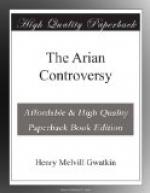[Sidenote: Confusion of: (1) Churches.]
Meanwhile the churches of Asia seemed in a state of universal dissolution. Disorder under Constantius had become confusion worse confounded under Valens. The exiled bishops were so many centres of disaffection, and personal quarrels had full scope everywhere. Thus when Basil’s brother Gregory was expelled from Nyssa by a riot got up by Anthimus of Tyana, he took refuge under the eyes of Anthimus at Doara, where a similar riot had driven out the Arian bishop. Pastoral work was carried on under the greatest difficulties. The exiles could not attend to their churches, the schemers would not, and the fever of controversy was steadily demoralizing both flocks and pastors.
[Sidenote: (2.) Creeds.]
Creeds were in the same confusion. The Homoeans as a body had no consistent principle at all beyond the rejection of technical terms, so that their doctrinal statements are very miscellaneous. They began with the indefinite Sirmian creed, but the confession they imposed on Eustathius of Sebastia was purely Macedonian. Some of their bishops were Nicenes, others Anomoeans. There was room for all in the happy family presided over by Eudoxius and his successor Demophilus. In this anarchy of doctrine, the growth of irreligious carelessness kept pace with that of party bitterness. Ecclesiastical history records no clearer period of decline than this. There is a plain descent from Athanasius to Basil, a rapid one from Basil to Theophilus and Cyril. The victors of Constantinople are but the epigoni of a mighty contest.
[Sidenote: Hopeful signs.]
Hopeful signs indeed were not entirely wanting. If the Nicene cause did not seem to gain much ground in Pontus, it was at least not losing. While Basil held the court in check, the rising power of asceticism was declaring itself every day more plainly on his side. One schism was healed by the reception of the Marcellians; and if Apollinarius was forming another, he was at least a resolute enemy of Arianism. The submission of the Lycian bishops in 375 helped to isolate the Semiarian phalanx in Asia, and the Illyrian council held in the same year by Ambrose was the first effective help from the West. It secured a rescript of Valentinian in favour of the Nicenes; and if he did not long survive, his action was enough to show that Valens might not always be left to carry out his plans undisturbed.
CHAPTER VIII.
THE FALL OF ARIANISM.
[Sidenote: Prospects in 375.]
The fiftieth year from the great council came and went, and brought no relief to the calamities of the churches. Meletius and Cyril were still in exile, East and West were still divided over the consecration of Paulinus, and now even Alexandria had become the prey of Lucius. The leaden rule of Valens still weighed down the East, and Valens was scarcely yet past middle life, and might reign for many years longer. The deliverance came suddenly, and the Nicene faith won its victory in the confusion of the greatest disaster which had ever yet befallen Rome.




